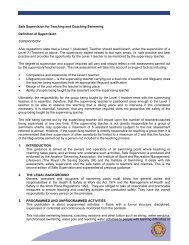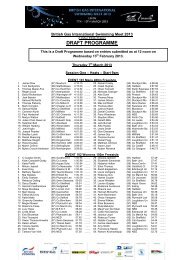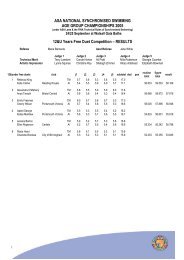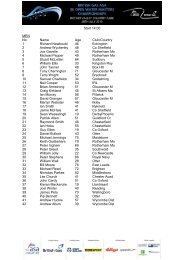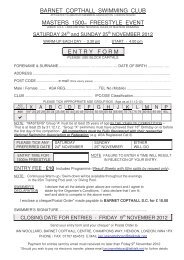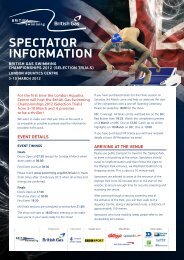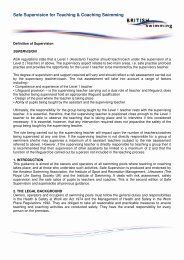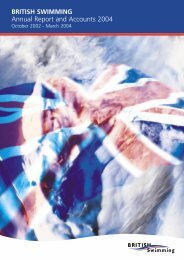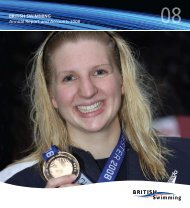Energy efficiency in swimming pools - Swimming.Org
Energy efficiency in swimming pools - Swimming.Org
Energy efficiency in swimming pools - Swimming.Org
Create successful ePaper yourself
Turn your PDF publications into a flip-book with our unique Google optimized e-Paper software.
GOOD PRACTICE GUIDE 219<br />
GOOD PRACTICE GUIDE 219<br />
<strong>Energy</strong> <strong>efficiency</strong> <strong>in</strong> swimm<strong>in</strong>g <strong>pools</strong><br />
– for centre managers and operators<br />
BEST PRACTICE<br />
PROGRAMME
ENERGY EFFICIENCY IN SWIMMING POOLS<br />
CONTENTS<br />
1 INTRODUCTION 4<br />
2 HEAT PRODUCTION 6<br />
3 HEAT SUPPLY 8<br />
4 VENTILATION AND AIR QUALITY 9<br />
5 HEAT RECOVERY 10<br />
6 OTHER ISSUES 12<br />
FURTHER READING AND REFERENCES 14<br />
Light<strong>in</strong>g<br />
Fans and pumps<br />
General power<br />
Space heat<strong>in</strong>g<br />
Heat recovery<br />
Water heat<strong>in</strong>g<br />
Dehumidification<br />
(and heat recovery)
This Guide has been developed<br />
to help pool centre managers<br />
and operators ensure that<br />
energy is managed efficiently<br />
at their facilities. With the<br />
complex range of build<strong>in</strong>g<br />
services <strong>in</strong> these centres, and<br />
their large demand on energy,<br />
it is important that<br />
opportunities for energy and<br />
cost sav<strong>in</strong>gs are highlighted.<br />
All of the technologies<br />
discussed <strong>in</strong> this Guide have<br />
been tried and tested, and<br />
have resulted <strong>in</strong> substantial<br />
energy sav<strong>in</strong>gs to the <strong>in</strong>dustry.<br />
INTRODUCTION<br />
INTRODUCTION<br />
Swimm<strong>in</strong>g pool halls are unlike any other type of<br />
build<strong>in</strong>g. They house large volumes of water which<br />
must be cont<strong>in</strong>uously filtered, treated and heated.<br />
In this humid environment the fabric of the<br />
build<strong>in</strong>g needs to be protected through adequate<br />
ventilation. Consequently, swimm<strong>in</strong>g <strong>pools</strong><br />
consume more energy per unit area than other<br />
build<strong>in</strong>g types. For example, they use five times as<br />
much energy per square metre as offices. Therefore<br />
swimm<strong>in</strong>g pool design and operation call for extra<br />
vigilance on the part of management.<br />
Typically, <strong>in</strong>door <strong>pools</strong> are <strong>in</strong> constant use – they<br />
are open almost every day of the year. They are<br />
volum<strong>in</strong>ous build<strong>in</strong>gs, and they:<br />
■ conta<strong>in</strong> large open areas of warm water which<br />
are constantly be<strong>in</strong>g agitated by bathers or<br />
water features<br />
■ have constantly high <strong>in</strong>ternal temperatures<br />
(often up to 30ºC)<br />
■ need substantial ventilation systems to<br />
ma<strong>in</strong>ta<strong>in</strong> comfortable conditions, to help<br />
regulate evaporation from the pool surface and<br />
to protect the fabric of the build<strong>in</strong>g.<br />
5<br />
ENERGY EFFICIENCY IN SWIMMING POOLS<br />
<strong>Energy</strong> costs represent a substantial proportion of<br />
the overall operat<strong>in</strong>g costs of a typical pool –<br />
usually 25%. <strong>Energy</strong> <strong>efficiency</strong> is a practical way of<br />
reduc<strong>in</strong>g operat<strong>in</strong>g costs without lower<strong>in</strong>g the<br />
standard of service to users.<br />
Where the energy is used<br />
The energy used for different purposes <strong>in</strong> a pool<br />
hall, and the result<strong>in</strong>g costs, are shown <strong>in</strong> figure 1.<br />
Design <strong>in</strong>tegration<br />
Environmental services, <strong>in</strong>clud<strong>in</strong>g pool water<br />
treatment, form a core element of the overall<br />
build<strong>in</strong>g design. The follow<strong>in</strong>g services should be<br />
carefully <strong>in</strong>tegrated <strong>in</strong>to the design:<br />
■ heat<strong>in</strong>g<br />
■ ventilation<br />
■ electrical services<br />
■ pool water treatment<br />
■ domestic water supply.<br />
In addition, the architectural and structural<br />
aspects of the build<strong>in</strong>g should be <strong>in</strong>tegrated with,<br />
and serve to enhance, the energy-efficient design<br />
features of the swimm<strong>in</strong>g pool.<br />
Figure 1<br />
(a) Proportion of energy used <strong>in</strong> an <strong>in</strong>door pool (b) Cost of energy used <strong>in</strong> an <strong>in</strong>door pool (%)
Option appraisal<br />
Given a pool which is consum<strong>in</strong>g more energy<br />
than desired as <strong>in</strong>dicated by the ‘typical’ energy<br />
figures (table 1), it is important to consider ways<br />
<strong>in</strong> which it can be made more energy efficient.<br />
Assum<strong>in</strong>g that all the plant is work<strong>in</strong>g correctly,<br />
and the appropriate operational procedures are<br />
adhered to, then <strong>in</strong>vestment <strong>in</strong> energy <strong>efficiency</strong><br />
measures must be considered. <strong>Energy</strong> <strong>efficiency</strong><br />
measures will also need to be considered dur<strong>in</strong>g<br />
refurbishment – for example, when age<strong>in</strong>g plant<br />
may need to be replaced – or when specify<strong>in</strong>g a<br />
new pool.<br />
Typical measures which may be considered<br />
would be:<br />
■ comb<strong>in</strong>ed heat and power (CHP)<br />
■ condens<strong>in</strong>g boilers<br />
■ ventilation heat recovery<br />
■ variable ventilation rates<br />
■ pool water heat recovery.<br />
Each of these offer significant improvements <strong>in</strong><br />
energy <strong>efficiency</strong> and could produce attractive<br />
pay-back periods. However, because of the complex<br />
nature of the energy use <strong>in</strong> a swimm<strong>in</strong>g pool, care<br />
must be taken when calculat<strong>in</strong>g the benefits of<br />
energy <strong>efficiency</strong> measures. If the cost-effectiveness<br />
of each of these is taken <strong>in</strong> isolation it may give a<br />
mislead<strong>in</strong>g impression of the benefits achieved<br />
when they are comb<strong>in</strong>ed. For example, the costeffectiveness<br />
of a CHP system may be lessened as a<br />
consequence of reduced electrical and heat<strong>in</strong>g<br />
demand result<strong>in</strong>g from <strong>in</strong>stall<strong>in</strong>g variable speed<br />
ventilation fans with heat recovery.<br />
To ensure that the most cost-effective techniques<br />
are selected, it is essential that the full range of<br />
energy <strong>efficiency</strong> measures are <strong>in</strong>vestigated by a<br />
process of option appraisal.<br />
It is recommended that a two stage approach is<br />
adopted to assess the benefits of a number of<br />
ENERGY EFFICIENCY IN SWIMMING POOLS<br />
INTRODUCTION<br />
Typical annual energy use<br />
(kWh/m 2 )<br />
Sports centre with pool:<br />
Good Fair Poor<br />
745<br />
Dry sports centre:<br />
Good Fair Poor<br />
410<br />
(Source: <strong>Energy</strong> Consumption Guide 51, ‘<strong>Energy</strong> <strong>efficiency</strong> <strong>in</strong><br />
sports and recreation build<strong>in</strong>gs’, p2)<br />
Table 1<br />
Typical pool operat<strong>in</strong>g costs (%)<br />
Labour 35<br />
Interest on capital 25-35<br />
<strong>Energy</strong> 25-30<br />
Ma<strong>in</strong>tenance, rates and supplies 10-15<br />
Table 2<br />
measures. In the first stage the <strong>in</strong>dividual pay-back<br />
periods of each measure are calculated and the<br />
most cost-effective measure selected as a priority.<br />
The second stage then <strong>in</strong>volves the addition of<br />
the less cost-effective measures <strong>in</strong> turn, and the<br />
calculation of the overall pay-back period for the<br />
package of measures. By this means the<br />
<strong>in</strong>cremental value of each measure – taken <strong>in</strong> the<br />
context of other measures – is more accurately<br />
determ<strong>in</strong>ed, and the risk of adopt<strong>in</strong>g measures<br />
based on unrealistic pay-back periods is<br />
elim<strong>in</strong>ated. This exercise should be carried out<br />
<strong>in</strong> consultation with a competent build<strong>in</strong>g<br />
services eng<strong>in</strong>eer.<br />
6<br />
FURTHER READING<br />
<strong>Energy</strong> Consumption<br />
Guide 51
HEAT PRODUCTION<br />
DESIGN ISSUES<br />
Fuel<br />
The most important factors to be considered <strong>in</strong><br />
the selection of fuel and the means of heat<br />
production are:<br />
■ the availability and convenience of the fuel<br />
■ the <strong>efficiency</strong> of the means of heat<br />
production<br />
■ the price.<br />
Other factors that should <strong>in</strong>fluence the choice of<br />
fuel are:<br />
■ the environmental issues<br />
■ the methods of handl<strong>in</strong>g the fuel<br />
■ the level of ma<strong>in</strong>tenance associated with<br />
the fuel<br />
■ the means of production and distribution.<br />
Unless there is some particular local energy source<br />
that warrants consideration (such as waste, process<br />
energy, or renewable sources such as solar or w<strong>in</strong>d<br />
power), the choice will normally be restricted to<br />
coal, oil, natural gas or bottled liquefied petroleum<br />
gas (LPG), or electricity. (For most <strong>pools</strong>, coal is<br />
unlikely to be appropriate because of the<br />
requirements of storage, handl<strong>in</strong>g and ma<strong>in</strong>tenance.)<br />
The environmental effects of different fuel<br />
options should be taken <strong>in</strong>to account (table 3).<br />
Note that electricity is not a primary fuel but has<br />
to be produced and distributed, thereby<br />
entail<strong>in</strong>g substantial energy loss and carbon<br />
dioxide (CO2) emissions.<br />
The method <strong>in</strong> which the fuel is used will be the<br />
next determ<strong>in</strong><strong>in</strong>g factor <strong>in</strong> energy <strong>efficiency</strong>.<br />
Heat production<br />
The ma<strong>in</strong> heat<strong>in</strong>g requirement for a swimm<strong>in</strong>g<br />
pool is to heat the pool water and the pool hall air<br />
supply. The most efficient way to supply and<br />
control this heat is by means of heat exchangers<br />
us<strong>in</strong>g heated water of low or medium temperature.<br />
7<br />
ENERGY EFFICIENCY IN SWIMMING POOLS<br />
CO2 emissions per unit of delivered<br />
energy (kg/kWh)<br />
Gas 0.19<br />
Oil 0.28<br />
Coal 0.32<br />
Electricity 0.63<br />
(Source: <strong>Energy</strong> Consumption Guide 51, p6)<br />
Table 3<br />
Typical seasonal efficiencies* (%)<br />
CHP >75<br />
Gas boiler 80<br />
Condens<strong>in</strong>g boiler 90<br />
Solid fuel 75<br />
Oil boiler 75<br />
Electric heaters 100 at po<strong>in</strong>t of<br />
use (only 30% <strong>in</strong><br />
primary energy<br />
terms)<br />
*Seasonal <strong>efficiency</strong> is def<strong>in</strong>ed as the average thermal <strong>efficiency</strong><br />
over a year under all operat<strong>in</strong>g conditions<br />
Table 4<br />
The usual methods of produc<strong>in</strong>g the required<br />
heat are:<br />
■ CHP units<br />
■ condens<strong>in</strong>g boilers<br />
■ modern standard or modular boilers<br />
■ standard boilers<br />
■ heat pumps.<br />
A list of typical seasonal efficiencies is given <strong>in</strong><br />
table 4. CHP units produce heat and electrical<br />
power from the same unit us<strong>in</strong>g a s<strong>in</strong>gle fuel<br />
source. The maximum <strong>efficiency</strong> of CHP units can<br />
exceed 90% but to achieve this they need to run<br />
at full load for as many hours as possible –<br />
provided there is sufficient demand for both heat<br />
and electrical power. Swimm<strong>in</strong>g <strong>pools</strong> often<br />
provide the ideal circumstances for this.
Electricity<br />
Heat production<br />
Condens<strong>in</strong>g boilers can be particularly effective <strong>in</strong><br />
pool <strong>in</strong>stallations and payback on the extra cost<br />
can be achieved <strong>in</strong> 2-3 years when compared with<br />
conventional non-condens<strong>in</strong>g boilers.<br />
A comb<strong>in</strong>ation of these options can be used. For<br />
example, CHP could fulfil the baseload<br />
requirement, with condens<strong>in</strong>g or modular boilers<br />
to cater for the peak loads.<br />
Heat pumps are probably most cost-effective as<br />
part of a heat recovery/dehumidification system.<br />
OPERATIONAL ISSUES<br />
Fuel<br />
Provided the type of fuel used rema<strong>in</strong>s the most<br />
appropriate, regular checks should be carried out to<br />
ENERGY EFFICIENCY IN SWIMMING POOLS<br />
HEAT PRODUCTION<br />
ensure that it is be<strong>in</strong>g bought at the most<br />
beneficial tariff. Check:<br />
■ the price be<strong>in</strong>g paid for fuels<br />
■ that relevant tariffs cont<strong>in</strong>ue to be competitive<br />
■ whether there have been any changes to the<br />
pool or its method of operation.<br />
Heat production<br />
It is essential that the heat production plant is<br />
operated efficiently and is properly ma<strong>in</strong>ta<strong>in</strong>ed.<br />
The <strong>efficiency</strong> of heat-generat<strong>in</strong>g plant can be<br />
reduced substantially if burners and control<br />
equipment are not serviced and adjusted regularly.<br />
Advice on ma<strong>in</strong>tenance <strong>in</strong> sports centres is given <strong>in</strong><br />
Good Practice Guide 137. CHP units <strong>in</strong> particular<br />
require regular specialist servic<strong>in</strong>g if they are to be<br />
reliable and operate at maximum <strong>efficiency</strong>.<br />
8<br />
Comb<strong>in</strong>ed heat and power<br />
units produce heat and<br />
electrical power from the same<br />
unit us<strong>in</strong>g a s<strong>in</strong>gle fuel source<br />
FURTHER READING<br />
Good Practice Guides 137,<br />
144, 187; <strong>Energy</strong><br />
Consumption Guide 51;<br />
Good Practice Case Studies<br />
43, 74, 280, 281; CIBSE CHP<br />
Information Pack
The optimum<br />
operat<strong>in</strong>g<br />
temperature will depend<br />
on the type of pool activity<br />
LEGIONELLA<br />
When consider<strong>in</strong>g energy sav<strong>in</strong>g<br />
measures for domestic hot water,<br />
it is essential that requirements<br />
for the control of Legionella (by<br />
ma<strong>in</strong>ta<strong>in</strong><strong>in</strong>g sufficiently high<br />
water temperatures) are not<br />
compromised. Full guidance is<br />
given <strong>in</strong> CIBSE Technical<br />
Memorandum 13<br />
Recommended pool<br />
temperatures (°C)<br />
Fitness 27<br />
Recreational 28<br />
Leisure 29<br />
Children 30<br />
Table 5<br />
REFERENCES<br />
Good Practice Guides 130, 144, 146;<br />
Good Practice Case Study 76; Pool<br />
Water Guide (PWTAG)<br />
HEAT SUPPLY<br />
DESIGN ISSUES<br />
It is important that optimal use is made of the<br />
heat produced, and the follow<strong>in</strong>g elements require<br />
careful consideration (particularly with regard to<br />
the relatively low temperatures and high flow<br />
rates <strong>in</strong> swimm<strong>in</strong>g pool facilities):<br />
■ heat exchangers<br />
■ pumps<br />
■ heat emitters (radiators, convectors etc)<br />
■ circulation and distribution systems.<br />
Pool water heat<strong>in</strong>g<br />
The optimum operat<strong>in</strong>g temperature for each<br />
particular pool or water area will depend on:<br />
■ the type of pool (eg competition, leisure,<br />
teach<strong>in</strong>g, div<strong>in</strong>g)<br />
■ the activity tak<strong>in</strong>g place<br />
■ the occupants.<br />
It is impracticable to vary the water temperature<br />
with<strong>in</strong> a s<strong>in</strong>gle pool. However, it is recommended<br />
that separate bodies of water can be heated by<br />
means of a separate heat exchanger and/or control<br />
circuit to the recommended pool temperatures<br />
<strong>in</strong>dicated <strong>in</strong> table 5.<br />
Shell and tube heat exchangers have traditionally<br />
been used <strong>in</strong> swimm<strong>in</strong>g <strong>pools</strong>. However, plate heat<br />
exchangers are now more efficient, and are easier<br />
to control and ma<strong>in</strong>ta<strong>in</strong>. It is important that they<br />
are selected carefully and are matched to the<br />
appropriate load (pool water is normally heated at<br />
a rate of 0.5ºC per hour).<br />
Domestic hot water<br />
Typically there will be a considerable requirement<br />
for domestic hot water (DHW) for pre-swim and<br />
9<br />
ENERGY EFFICIENCY IN SWIMMING POOLS<br />
Domestic hot water<br />
Store at 60ºC; distribute at 55ºC;<br />
PRE-SWIM SHOWER<br />
Supply at 2ºC above pool<br />
temperature (ie 31/32ºC)<br />
POST-SWIM SHOWER<br />
Supply at 40ºC<br />
Table 6<br />
post-swim showers. It is recommended that local<br />
energy-sav<strong>in</strong>g shower controls (such as percussion<br />
timer controls) be <strong>in</strong>corporated.<br />
Hot water can be provided from either storage or<br />
non-storage calorifiers served by primary hot water<br />
from the boiler or CHP plant, or by means of<br />
direct-fired hot water generators. Great care must<br />
be taken to avoid the <strong>in</strong>cubation of Legionella<br />
(table 6). Careful assessment of the estimated load<br />
patterns and heat requirements should result <strong>in</strong><br />
the selection of the most energy-efficient option.<br />
OPERATIONAL ISSUES<br />
Pool water heat<strong>in</strong>g<br />
Although the pool water temperature is controlled<br />
automatically, there is a need for frequent<br />
check<strong>in</strong>g because temperature sensors may drift.<br />
Even a 0.5ºC rise will result <strong>in</strong> a substantial waste<br />
of energy, because of the high thermal capacity of<br />
water. There will also be a significant <strong>in</strong>crease <strong>in</strong><br />
the rate of evaporation, which will, <strong>in</strong> turn, lead<br />
to a need for <strong>in</strong>creased ventilation <strong>in</strong> order to<br />
protect the build<strong>in</strong>g fabric and ma<strong>in</strong>ta<strong>in</strong> a<br />
comfortable air temperature.<br />
It is essential that the temperature of each separate<br />
pool or water area is:<br />
■ checked several times a day and <strong>in</strong> various<br />
locations<br />
■ adjusted to the optimum level for the activity<br />
<strong>in</strong> progress<br />
■ set to the lowest temperature compatible with<br />
the comfort and satisfaction of users.<br />
Automatic control sett<strong>in</strong>gs should be checked<br />
aga<strong>in</strong>st actual temperature read<strong>in</strong>gs to ensure that<br />
the relevant controls rema<strong>in</strong> correctly calibrated.<br />
Domestic hot water<br />
To ensure that the DHW supply services operate<br />
efficiently and without waste, operators should<br />
regularly check that:<br />
■ showers and taps operate only when required<br />
■ showers and taps are not dripp<strong>in</strong>g<br />
■ heat exchangers are clean (check temperatures<br />
and pressure across the heat exchanger)<br />
■ controls are properly set and calibrated.
DESIGN ISSUES<br />
Ma<strong>in</strong>ta<strong>in</strong><strong>in</strong>g the appropriate levels of temperature,<br />
humidity and air quality with<strong>in</strong> the pool hall for<br />
bathers, staff and spectators is a difficult and<br />
complex task for designers and operators.<br />
The pool hall air quality will be cont<strong>in</strong>ually<br />
reduced by the heat, humidity and a mixture of<br />
chemicals which pass from the pool water by<br />
means of evaporation and heat transfer. The pool<br />
hall ventilation system is usually the only means<br />
of remov<strong>in</strong>g contam<strong>in</strong>ants, so it is critical that it<br />
provides adequate ventilation.<br />
Experience over many years has <strong>in</strong>dicated that the<br />
optimum balance between pool water and air<br />
conditions is achieved by:<br />
■ ma<strong>in</strong>ta<strong>in</strong><strong>in</strong>g the pool air at the same<br />
temperature as, or slightly higher than, the<br />
pool water (up to +1ºC)<br />
■ ma<strong>in</strong>ta<strong>in</strong><strong>in</strong>g the humidity at about 60%<br />
relative humidity.<br />
It is generally recommended that the air<br />
temperature should not exceed 30ºC, and that the<br />
relative humidity should be ma<strong>in</strong>ta<strong>in</strong>ed between<br />
50% and 70%.<br />
The optimum ventilation rate depends on a wide<br />
range of operat<strong>in</strong>g conditions, <strong>in</strong>clud<strong>in</strong>g:<br />
■ variations <strong>in</strong> water temperature<br />
■ water quality<br />
■ number of bathers<br />
■ water agitation<br />
■ water features<br />
■ external conditions.<br />
An effective, well-distributed and mechanically<br />
controlled supply and extract system will be<br />
required. This will ensure that appropriate<br />
conditions are ma<strong>in</strong>ta<strong>in</strong>ed throughout the<br />
occupied zone and that air movement is<br />
ma<strong>in</strong>ta<strong>in</strong>ed with<strong>in</strong> acceptable limits for bather<br />
comfort. Conditions <strong>in</strong> a pool usually vary so<br />
frequently that a prescriptive design to suit all<br />
possible situations is not feasible.<br />
ENERGY EFFICIENCY IN SWIMMING POOLS<br />
VENTILATION AND AIR QUALITY<br />
Dur<strong>in</strong>g periods when there are fewer<br />
bathers energy <strong>efficiency</strong> may be<br />
improved by:<br />
■ reduc<strong>in</strong>g the ventilation rate<br />
■ reduc<strong>in</strong>g the <strong>in</strong>take of fresh air.<br />
Variable-volume fans or variable fresh<br />
air/recirculation air dampers generally<br />
achieve this. Where air circulation<br />
quantities are variable, care must be<br />
taken to ensure that, with<strong>in</strong> the pool<br />
hall, the air distribution is not impaired<br />
and that air quality is not reduced below<br />
comfort levels.<br />
OPERATIONAL ISSUES<br />
The ventilation system must be operated<br />
at optimum levels at all times to achieve<br />
maximum energy <strong>efficiency</strong>.<br />
■ Make sure that the operation of fans, filters,<br />
heat exchangers and dampers rema<strong>in</strong>s with<strong>in</strong><br />
the design specification (Good Practice Guide<br />
137 gives details).<br />
■ Adjust the temperature and humidity if necessary.<br />
■ Adjust the ventilation air supply when<br />
necessary.<br />
■ Cover the pool when it is not <strong>in</strong> use.<br />
Where variable ventilation volume or partial<br />
recirculation systems are employed, or there are<br />
changes <strong>in</strong> the operation or occupancy of the<br />
pool, it may be necessary to check and, where<br />
required, manually override any automatic control<br />
systems for that period of operation.<br />
Pool covers (see Good Practice Case Study 76),<br />
where available, should always be used when the<br />
pool is unoccupied <strong>in</strong> order to m<strong>in</strong>imise<br />
evaporation and allow some air recirculation or<br />
reduced ventilation.<br />
Recommended conditions<br />
10<br />
Variable ventilation<br />
FURTHER READING<br />
Sports Council Guidance<br />
Notes: Swimm<strong>in</strong>g Pools –<br />
build<strong>in</strong>g services<br />
GPG 137, GPCS 76<br />
Table 7<br />
Air temperature: typically 30˚C<br />
Relative humidity: 50-70%<br />
Ventilation (general guidel<strong>in</strong>e): 10 litres per second per square metre of total pool<br />
hall area (water plus wet surrounds)<br />
■ 4-6 air changes per hour standard use 8-10 air changes with extensive water features<br />
■ M<strong>in</strong>imum 12 litres per person per second (<strong>in</strong>cludes all occupants)<br />
■ 100% fresh air operation should be available
Def<strong>in</strong>itions<br />
Sensible heat is the heat<br />
associated with a change <strong>in</strong><br />
temperature<br />
Latent heat is the heat<br />
associated with a change of<br />
state (eg condensation)<br />
Heat recovery devices can be<br />
used to recover heat from<br />
both the ventilation and<br />
pool water systems<br />
HEAT RECOVERY<br />
DESIGN ISSUES<br />
Most of the energy load of a swimm<strong>in</strong>g pool is<br />
used to heat the pool water and pool air. In order<br />
to control pool hall air quality large amounts of<br />
heated moist air are expelled from the hall. Heat<br />
from pool water is also discharged dur<strong>in</strong>g the<br />
backwash<strong>in</strong>g of filters, or when water is dumped <strong>in</strong><br />
order to dilute with fresh make-up water.<br />
Considerable scope therefore exists for the use of<br />
heat recovery systems.<br />
The most important means of heat recovery <strong>in</strong> a<br />
pool is usually the pool hall ventilation system.<br />
Sensible heat recovery devices<br />
The simplest forms of heat reclamation systems for<br />
pool hall ventilation are sensible heat recovery<br />
devices. There are three ma<strong>in</strong> types.<br />
■ The cross-flow heat exchanger, capable of<br />
recover<strong>in</strong>g up to 75% of the sensible heat, is<br />
the most efficient of the three types. It<br />
comprises a series of parallel plates between<br />
the supply and extract ducts, which allow heat<br />
exchange from the warmer extract air to the<br />
11<br />
ENERGY EFFICIENCY IN SWIMMING POOLS<br />
cooler <strong>in</strong>let air. Supply and extract routes must<br />
be immediately adjacent to each other.<br />
■ Run-around coils are probably the most<br />
flexible type of heat recovery device, although<br />
typical <strong>efficiency</strong> is only about 60%. Two heat<br />
exchange coils, one <strong>in</strong> the supply duct and<br />
one <strong>in</strong> the extract duct, are l<strong>in</strong>ked by pipework<br />
carry<strong>in</strong>g a heat transfer fluid. The fluid is<br />
pumped between the two, transferr<strong>in</strong>g heat<br />
from the warmer extract air stream to the<br />
cooler <strong>in</strong>let. The supply and extract systems<br />
do not need to be close to each other,<br />
mak<strong>in</strong>g this system particularly flexible and<br />
especially suitable for refurbishment and<br />
improvement projects.<br />
■ The thermal wheel system achieves heat<br />
transfer us<strong>in</strong>g a rotat<strong>in</strong>g disc-shaped<br />
heat-retentive honeycomb matrix, through<br />
which air can pass. The disc rotates through<br />
both supply and extract air streams at about<br />
20 rpm. Heat is transferred via the wheel from<br />
the warmer extract duct to the cooler supply<br />
air system. This system requires the supply<br />
and extract ducts to be close to each other and<br />
occupies more space than other systems. Heat<br />
transfer efficiencies of up to 75% have been<br />
achieved but, because of its mov<strong>in</strong>g parts, this<br />
device generally requires more ma<strong>in</strong>tenance<br />
than alternative types of heat recovery device.<br />
Pool water heat recovery<br />
Whenever warm pool water is discharged dur<strong>in</strong>g<br />
backwash<strong>in</strong>g (or when fresh water is <strong>in</strong>troduced<br />
for dilution purposes) it can be used to heat<br />
<strong>in</strong>com<strong>in</strong>g fresh water. The most effective and<br />
energy efficient device for this purpose is likely to<br />
be a cross-flow plate heat exchanger.
Sensible and latent heat recovery<br />
■ The warm, moist air extracted from a pool hall<br />
conta<strong>in</strong>s both sensible and latent heat energy.<br />
If a dehumidification system is used,<br />
much of the latent energy can be released as<br />
the vapour condenses and the temperature<br />
falls. Dehumidification devices can be used to<br />
control the humidity of pool hall air by<br />
remov<strong>in</strong>g water vapour without requir<strong>in</strong>g<br />
excessive amounts of fresh air. This saves<br />
energy by reduc<strong>in</strong>g the amount of cold air to<br />
be heated, and recover<strong>in</strong>g latent heat.<br />
However, care should be taken to ma<strong>in</strong>ta<strong>in</strong><br />
sufficient fresh air supply; it is critical to<br />
satisfy both environmental and comfort<br />
conditions.<br />
■ Where heat pumps are used to recover<br />
exhaust heat, the evaporator removes sensible<br />
and latent heat from the extract air. This heat<br />
is then imparted at the condenser to the<br />
delivery airstream, which is a mixture of cold<br />
saturated air and outside air.<br />
ENERGY EFFICIENCY IN SWIMMING POOLS<br />
HEAT RECOVERY<br />
■ A gas-fired desiccant wheel, conta<strong>in</strong><strong>in</strong>g a<br />
chemically treated honeycomb matrix, works<br />
<strong>in</strong> a similar way to the thermal wheel by<br />
recover<strong>in</strong>g sensible and latent heat from the<br />
pool air.<br />
OPERATIONAL ISSUES<br />
The technologies described <strong>in</strong> this section need to<br />
be operated and ma<strong>in</strong>ta<strong>in</strong>ed effectively if they are<br />
to realise their full potential for heat recovery.<br />
Simple cross-flow plate heat exchangers require<br />
m<strong>in</strong>imal ma<strong>in</strong>tenance due to the absence of<br />
mov<strong>in</strong>g parts, but even these should be checked<br />
regularly for any blockages of the fluid pathways<br />
and contam<strong>in</strong>ation of the heat exchange surfaces.<br />
12<br />
FURTHER READING<br />
<strong>Energy</strong> Consumption<br />
Guide 51; Good Practice<br />
Guides 130, 137, 144, 146
REFERENCES<br />
Good Practice Guides 130,<br />
137, 144; Sports Council<br />
Guidance Notes 383, 387;<br />
CIBSE Light<strong>in</strong>g Guide LG4<br />
The specification of a<br />
swimm<strong>in</strong>g pool should <strong>in</strong>clude<br />
energy-efficient light<strong>in</strong>g,<br />
control, heat recovery, and<br />
<strong>in</strong>sulation. Good design will<br />
assist those who use and<br />
operate the pool <strong>in</strong><br />
the future<br />
OTHER ISSUES<br />
OTHER ISSUES<br />
The issues highlighted below are not specific to<br />
<strong>pools</strong>, nevertheless they are important, and require<br />
consideration.<br />
Light<strong>in</strong>g<br />
Usually about 16% of the energy cost of an <strong>in</strong>door<br />
swimm<strong>in</strong>g pool is attributable to the artificial<br />
light<strong>in</strong>g, which may need to be on for 16 hours or<br />
more each day. Us<strong>in</strong>g high-<strong>efficiency</strong> lamps with<br />
appropriate controls can make sav<strong>in</strong>gs of up to<br />
50%. Good housekeep<strong>in</strong>g and low-cost measures,<br />
such as planned ma<strong>in</strong>tenance, can also reduce<br />
runn<strong>in</strong>g costs.<br />
Build<strong>in</strong>g fabric<br />
In the pool hall environment, the fabric of the<br />
build<strong>in</strong>g is a crucial issue that should be<br />
considered at the design stage. The thermal quality<br />
of the build<strong>in</strong>g fabric is more important for pool<br />
halls than for most other types of build<strong>in</strong>g. Pool<br />
halls are, <strong>in</strong> general, ma<strong>in</strong>ta<strong>in</strong>ed at temperatures<br />
about 10ºC higher than most conventional<br />
build<strong>in</strong>gs, and may suffer up to 50% more heat<br />
loss than other facilities with similar <strong>in</strong>sulation<br />
13<br />
ENERGY EFFICIENCY IN SWIMMING POOLS<br />
standards and external temperatures. Serious<br />
attention should therefore be paid to specify<strong>in</strong>g<br />
fabric <strong>in</strong>sulation levels up to 50% above those laid<br />
down <strong>in</strong> Build<strong>in</strong>g Regulations for both new-build<br />
and refurbishment.<br />
Refurbishment<br />
Refurbishment offers many opportunities for<br />
improv<strong>in</strong>g the energy performance of the build<strong>in</strong>g<br />
and its services at little extra cost. Build<strong>in</strong>g fabric,<br />
light<strong>in</strong>g, heat<strong>in</strong>g and ventilation systems all need<br />
careful consideration. A heat recovery system<br />
appropriate to the facility can be a particularly<br />
cost-effective <strong>in</strong>stallation <strong>in</strong> exist<strong>in</strong>g swimm<strong>in</strong>g<br />
<strong>pools</strong>. Run-around coil systems are especially<br />
attractive for recover<strong>in</strong>g heat from parts of the<br />
facility that are separated from each other.<br />
Power correction equipment<br />
In centres that have a high electrical load – for<br />
equipment such as wave mach<strong>in</strong>es – it is a good idea<br />
to determ<strong>in</strong>e the power factor. Installation of power<br />
factor correction equipment may be worthwhile.<br />
Heat<strong>in</strong>g and ventilat<strong>in</strong>g other areas<br />
Although of less significance than the pool hall<br />
itself, other areas of a pool build<strong>in</strong>g can have a<br />
significant impact on energy consumption.<br />
Heat recovery<br />
Chang<strong>in</strong>g-rooms provide an excellent opportunity<br />
to apply heat recovery techniques. They require a<br />
substantial quantity of entirely fresh ventilation air<br />
(about 10 air changes per hour) <strong>in</strong> order to provide<br />
adequate air quality, and they are normally<br />
ma<strong>in</strong>ta<strong>in</strong>ed at about 25ºC.<br />
Toilet areas also require substantial fresh air<br />
ventilation (about 10 air changes per hour) and<br />
heat recovery should therefore be considered.
ENERGY EFFICIENCY IN SWIMMING POOLS<br />
TADCASTER COMMUNITY SWIMMING<br />
POOL<br />
This new build<strong>in</strong>g was opened <strong>in</strong> December<br />
1994. The ma<strong>in</strong> pool is 25 m x 13 m, with<br />
a 12 m x 7 m learner pool.<br />
<strong>Energy</strong> <strong>efficiency</strong> measures:<br />
■ CHP unit<br />
■ air/air plate heat recovery<br />
■ high-<strong>efficiency</strong> boilers<br />
■ highly <strong>in</strong>sulated pool hall fabric.<br />
Pool conditions:<br />
■ pool water temperature: 29ºC<br />
■ pool air temperature: 30ºC, 55%<br />
relative humidity<br />
■ operat<strong>in</strong>g hours: 100 per week/5200<br />
per year.<br />
SPENBOROUGH POOL<br />
This pool was orig<strong>in</strong>ally built <strong>in</strong> 1969. It<br />
has a 33 m x 12 m ma<strong>in</strong> pool with a small<br />
teach<strong>in</strong>g pool of 12 m x 7 m. Substantial<br />
programmes of energy <strong>efficiency</strong><br />
refurbishment work were carried out <strong>in</strong> 1988<br />
and 1995.<br />
<strong>Energy</strong> <strong>efficiency</strong> measures:<br />
■ thermal wheel<br />
■ CHP unit<br />
■ pool cover<br />
■ energy management system<br />
■ modular boilers<br />
■ flue-gas heat recovery<br />
■ power factor correction.<br />
Pool conditions:<br />
■ ma<strong>in</strong> pool water temperature: 28-29ºC<br />
■ learner pool temperature: 29-30ºC.<br />
■ pool air: 30-32ºC, 60% relative humidity<br />
■ operat<strong>in</strong>g hours: 94 per week/4888<br />
per year.<br />
EXAMPLES<br />
14
FURTHER READING<br />
Sports Council Guidance Notes<br />
English Sports Council, 16 Upper Woburn Place,<br />
London WC1 0QP<br />
■ SCGN 383 Sports halls – light<strong>in</strong>g<br />
■ SCGN 387 Swimm<strong>in</strong>g <strong>pools</strong> – build<strong>in</strong>g services<br />
Chartered Institution of Build<strong>in</strong>g Services<br />
Eng<strong>in</strong>eers (CIBSE)<br />
Chartered Institution of Build<strong>in</strong>g Services<br />
Eng<strong>in</strong>eers, Delta House, 222 Balham High Road,<br />
London SW12 9BS<br />
■ CIBSE CHP Information pack, 1995<br />
■ Sports Light<strong>in</strong>g Guide, LG4, 1990<br />
■ CIBSE Technical Memorandum 13:<br />
‘M<strong>in</strong>imis<strong>in</strong>g the risk of Legionnaires’ Disease’<br />
Pool Water Treatment Advisory Group (PWTAG)<br />
PWTAG, Field House, Thrawdeston, Diss,<br />
Norfolk IP21 4BU<br />
■ Pool water guide – the treatment and quality<br />
of swimm<strong>in</strong>g pool water, 1995<br />
The follow<strong>in</strong>g Best Practice publications are<br />
available from BRECSU Enquiries Bureau. Contact<br />
details are given on the back cover.<br />
Introduction to <strong>Energy</strong> Efficiency Booklet<br />
7 Sports and recreation centres<br />
<strong>Energy</strong> Consumption Guide<br />
51 <strong>Energy</strong> <strong>efficiency</strong> <strong>in</strong> sports and recreation<br />
build<strong>in</strong>gs: a guide for owners and energy<br />
managers<br />
15<br />
DETR ENERGY EFFICIENCY BEST<br />
PRACTICE PROGRAMME DOCUMENTS<br />
ENERGY EFFICIENCY IN SWIMMING POOLS<br />
Good Practice Guides<br />
130 Good housekeep<strong>in</strong>g <strong>in</strong> swimm<strong>in</strong>g <strong>pools</strong> –<br />
a guide for centre managers<br />
137 <strong>Energy</strong> <strong>efficiency</strong> <strong>in</strong> sports and recreation<br />
build<strong>in</strong>gs: effective plant ma<strong>in</strong>tenance. A<br />
guide for sports centre managers and<br />
ma<strong>in</strong>tenance staff<br />
144 <strong>Energy</strong> <strong>efficiency</strong> <strong>in</strong> sports and recreation<br />
build<strong>in</strong>gs: a technology overview. A guide for<br />
owners and managers<br />
146 <strong>Energy</strong> <strong>efficiency</strong> <strong>in</strong> sports and recreation<br />
build<strong>in</strong>gs: manag<strong>in</strong>g energy. A guide for<br />
sports centre managers<br />
176 Small-scale comb<strong>in</strong>ed heat and power for<br />
build<strong>in</strong>gs<br />
182 Heat<strong>in</strong>g system option appraisal –<br />
a manager’s guide<br />
187 Heat<strong>in</strong>g system option appraisal – an<br />
eng<strong>in</strong>eer’s guide for exist<strong>in</strong>g build<strong>in</strong>gs<br />
211 Draw<strong>in</strong>g a w<strong>in</strong>ner. <strong>Energy</strong> efficient design of<br />
sports centres<br />
Good Practice Case Studies<br />
43 <strong>Energy</strong> <strong>efficiency</strong> <strong>in</strong> sports and recreation<br />
build<strong>in</strong>gs: condens<strong>in</strong>g gas boilers<br />
74 <strong>Energy</strong> <strong>efficiency</strong> <strong>in</strong> sports and recreation<br />
build<strong>in</strong>gs: potential benefits of boiler<br />
replacement<br />
76 <strong>Energy</strong> <strong>efficiency</strong> <strong>in</strong> sports and recreation<br />
centres: swimm<strong>in</strong>g pool covers. Eastern<br />
Leisure Centre, Cardiff City Council<br />
280 <strong>Energy</strong> <strong>efficiency</strong> <strong>in</strong> sports and recreation<br />
build<strong>in</strong>gs. CHP – the ‘capital purchase’ option<br />
281 <strong>Energy</strong> <strong>efficiency</strong> <strong>in</strong> sports and recreation<br />
build<strong>in</strong>gs. CHP – the ‘supplier f<strong>in</strong>anced’ option
The Department of the Environment, Transport and the Regions’ <strong>Energy</strong> Efficiency<br />
Best Practice programme provides impartial, authoritative <strong>in</strong>formation on energy <strong>efficiency</strong><br />
techniques and technologies <strong>in</strong> <strong>in</strong>dustry and build<strong>in</strong>gs. This <strong>in</strong>formation is dissem<strong>in</strong>ated<br />
through publications, videos and software, together with sem<strong>in</strong>ars, workshops and other<br />
events. Publications with<strong>in</strong> the Best Practice programme are shown opposite.<br />
For further <strong>in</strong>formation on:<br />
Build<strong>in</strong>gs-related projects contact:<br />
Enquiries Bureau<br />
BRECSU<br />
BRE<br />
Garston, Watford, WD2 7JR<br />
Tel 01923 664258<br />
Fax 01923 664787<br />
E-mail brecsuenq@bre.co.uk<br />
Internet BRECSU – http://www.bre.co.uk/brecsu/<br />
Internet ETSU – http://www.etsu.com/eebpp/home.htm<br />
Industrial projects contact:<br />
<strong>Energy</strong> Efficiency Enquiries Bureau<br />
ETSU<br />
Harwell, Oxfordshire<br />
OX11 0RA<br />
Tel 01235 436747<br />
Fax 01235 433066<br />
E-mail etsuenq@aeat.co.uk<br />
<strong>Energy</strong> Consumption Guides: compare energy use <strong>in</strong> specific<br />
processes, operations, plant and build<strong>in</strong>g types.<br />
Good Practice: promotes proven energy efficient techniques<br />
through Guides and Case Studies.<br />
New Practice: monitors first commercial applications of new<br />
energy <strong>efficiency</strong> measures.<br />
Future Practice: reports on jo<strong>in</strong>t R&D ventures <strong>in</strong>to new energy<br />
<strong>efficiency</strong> measures.<br />
General Information: describes concepts and approaches yet<br />
to be established as good practice.<br />
Fuel Efficiency Booklets: give detailed <strong>in</strong>formation on specific<br />
technologies and techniques.<br />
Introduction to <strong>Energy</strong> Efficiency: helps new energy managers<br />
understand the use and costs of heat<strong>in</strong>g, light<strong>in</strong>g etc.<br />
© CROWN COPYRIGHT FIRST PRINTED SEPTEMBER 1997



